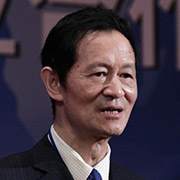The seventh China-U.S. Strategic and Economic Dialogue (S&ED) and the sixth China-U.S. High-Level Consultation on People-to-People Exchange (CPE) were held in Washington, D.C. on June 23 and 24. The dialogues and exchanges are conducive to strengthening trust and dispelling distrust, while pushing forward a new type of major-country relationship between the two countries.
The timing of the S&ED and CPE this year could not be better. It will lay a foundation for a successful visit by President Xi Jinping in September. Often this year, voices and debates have been heard in U.S. academia and strategic circles on the U.S. grand strategy towards China. Earlier this year, Michael Pillsbury, the former Assistant Under Secretary of Defense for Policy Planning, published a book called The Hundred-Year Marathon: China’s Secret Strategy to Replace America as the Global Superpower, arguing that China has long pursued a secret “cheating strategy” to surpass the U.S. as the global superpower in 2049. Therefore, the U.S. should wake up and take more assertive actions towards China. [i] In March, David Shambaugh, a professor of international affairs and the director of the China Policy Program at George Washington University, wrote an article on The Wall Street Journal entitled “The Coming Chinese Crackup”. [ii] Following these arguments, the Council on Foreign Relations released a special report, “Revising U.S. Grand Strategy Toward China” by Robert Blackwill and Ashley Tellis in April, arguing that competition between the two countries has become the new normal and “Washington needs a new grand strategy toward China”, namely to “balance” China’s rise, “because the American effort to ‘integrate’ China into the liberal international order has now generated new threats to U.S. primacy in Asia”.[iii] Facing such negative observations, David Lampton, a senior China scholar[iv], delivered a speech in May, worrying that China -U.S. relations were approaching “a tipping point”.[v]
Fortunately, we still have some other voices. Stephen Hadley, former national security advisor to President George W. Bush, and Paul Haenle, the director of the Carnegie-Tsinghua Center, published an article “The Catch-22 in U.S.-Chinese Relations” in Foreign Affairs, arguing the two countries should make a compromise: China removes its reference to core interests and the U.S. accepts the new type of major-country relations concept in order to build a more constructive and positive relationship. [vi] Recently, just one day before the S&ED and CPE, Jeffrey A. Bader, the former senior director for Asian affairs on the National Security Council, wrote a paper arguing that the U.S. should not abandon the approach taken by eight presidents since Nixon, since the policy toward China has “built and nurtured the U.S.-China relationship and built a generation of peace in Asia”.[vii]
Although the debate on U.S. policies towards China is becoming intense, China and the U.S. have good reasons to remain unswerving. First, I believe that these negative opinions transpiring in this debate are not the mainstream in U.S. academia and strategic circle. Second, this debate, in a sense, originates from the fact that some U.S. scholars are unable to catch up with the times and unable to better prepare for China’s rapid development. That uneasiness has given rise to a reviewing of the China policies taken by the U.S. Third, as the 2016 U.S. presidential election approaches, China’s return to the U.S. debate focus is not unusual. Cyber security and IPR protection would remain the hot issues in China-U.S. relations and possibly would stir more controversial voices on the bilateral relations. Fourth, mechanisms to control and manage differences and promote cooperation between China and the U.S. are still in place. The S&ED and CPE are shining examples. It is believed that the meeting between the two leaderships in September will send a clearer message to the world — that the China-U.S. relationship is not moving towards a “tipping point” or “derail”; rather it will step firmly towards a new type of major-country relations.
It should be noted that this year’s S&ED and CPE have become a “relief valve” and “propeller” for China-US relations. The rather intense vibe around the South China Sea and cyber security issues started to cool down before the dialogues and exchanges. Daniel R. Russel, U.S. Assistant Secretary of State for East Asian and Pacific Affairs, recently said the U.S. supports resolving South China Sea dispute through diplomatic means, and the U.S. and China should cooperate on Cyber security. S&ED and other high-level consultations are important mechanisms to improve the bilateral relations through a systematic framework, helping the two countries understand differences, build trust, expand cooperation and thus conducive to pragmatic discussion and cooperation between the two countries on bilateral and multilateral issues.
Looking beyond the 2016 presidential election, no matter whether a Democrat or a Republican will be in power, U.S. polices towards China would not intrinsically change. However, the two countries should carefully manage and control conflicts and deepen cooperation. On one hand, China and U.S. should keep timely communication so as to dispel the doubts one side harbors of the other. The U.S. is having a hard time distinguishing “subvert” and “reform” and believing China intends to “subvert” international order. However, China advocates reform of the existing international order and system. This reform is not to tear everything apart and start all over again. The U.S. is also suspicious of China harboring the intention of “setting up a new kitchen” in Asia and driving the U.S. out of Asia. Instead, China is keeping an open mind and an inclusive attitude for the region. Therefore, it is necessary to strengthen communication and exchanges on AIIB, “one belt and one road” initiative and other issues so as to increase the level of mutual trust.
The two countries should expand cooperation. There is no denying that elements of competition exist in China-U.S. relations, but strengthening bilateral cooperation still forms the major part of the two countries’ policies towards each other. China’s continued development and the relative decline of the U.S. in the world power structure is a fact both countries should face, though the U.S. will remain the only superpower in the world for a long time to come. However, high levels of economic interdependency, the development of bilateral cooperation mechanisms, and the fact that global issues cannot achieve “multi win” result unless U.S. and China are to act hand in hand are the forces drawing the two countries closer. In the meantime, cooperation and competition is not a pair of antonyms. The two countries cannot shun competition. Instead, seeking cooperation in competition, encouraging benign competition in cooperation and striking a balance between competition and cooperation would become the “new normal” which would prevent China-U.S. relations from the “tipping point”.
[i] Michael Pillsbury, The Hundred-Year Marathon: China’s Secret Strategy to Replace America as the Global Superpower, Henry Holt and Co., February 3, 2015.
[ii] David Shambaugh, “The Coming Chinese Crackup”, The Wall Street Journal, March 6, 2015http://www.wsj.com/articles/the-coming-chinese-crack-up-1425659198.
[iii] Robert Blackwill and Ashley Tellis, “Revising U.S. Grand Strategy Toward China”, Council Special Report No. 72, April 2015, http://www.cfr.org/china/revising-us-grand-strategy-toward-china/p36371?co=C009601.
[iv] According to the report “Evaluation Report on American China Experts” released by China Foreign Affairs University, David Lampton ranks the first, and interestingly, David Shambaugh ranks the second.
[v] David Lampton, A Tipping Point in U.S.-China Relations is Upon Us, May 6, 2015, http://www.uscnpm.org/blog/2015/05/11/a-tipping-point-in-u-s-china-relations-is-upon-us-part-i/#pq=JLQROo.
[vi] Stephen Hadley and Paul Haenle, “The Catch-22 in U.S.-Chinese Relations: The Future of Bilateral Ties”, February 22, 2015, https://www.foreignaffairs.com/articles/china/2015-02-22/catch-22-us-chinese-relations.
[vii] Jeffrey A. Bader, “Changing China policy: Are we in search of enemies?”, June 22, 2015, http://www.brookings.edu/blogs/up-front/posts/2015/06/22-changing-china-policy-bader.




